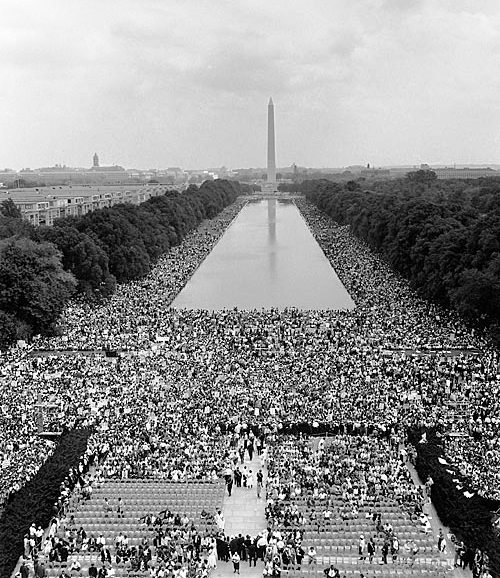
As President Donald Trump defends white supremacists, white nationalists, Neo-Nazis, the Ku Klux Klan, and the Alt-Right’s detestable ideology and violent actions, Americans seek alternative ways to resist, protest, and renounce the hate-filled vitriol of the far-right Neo-Nazis in America.
The solution is nonviolent action.
The candlelight vigil that was held in Charlottesville, Virginia on Wednesday evening is one approach to nonviolent action. However, there are a number of methods in the proverbial toolbox of nonviolent action that Americans can use to resist hate groups and those who support them—or defend them like President Trump.
Nonviolent action takes many forms and has been advocated for decades by leaders like Dr. Martin Luther King Jr. and Mahatma Gandhi. Although nonviolence lacks an extensive academic history, its practice and intellectual underpinnings have been refined by intellectuals, such as Dr. Gene Sharp. Sharp is a retired professor of political science at the University of Massachusetts Dartmouth and the founder of the Albert Einstein Institution, which focuses on the subject of nonviolence.
Sharp’s work has resulted in a coherent definition of nonviolent action and a typology that can inform each of us as we stand up to Neo-Nazi groups, their hate, and violent actions. His work is the result of careful study of the ideas and actions of people like Gandhi and Dr. King, their respective social movements, as well as other historical figures and the movements they led.
Nonviolent action as a technique consists, not simply of words, but of specific methods that are action-oriented. Nonviolent action is sometimes erroneously perceived as a passive, cowardly, or an inactive technique toward addressing political, social, economic, or cultural grievances. According to Sharp, this perception is wrong.
Nonviolent action is just what it says: action which is nonviolent, not inaction. It consist of active defiance, disobedience, and civil resistance, while relying on principled conduct and rejecting physical violence. It does not avoid confrontation or ignore conflict.[1]
In his three-volume series on nonviolent action, Sharp covered power and struggle, along with the dynamics and methods of nonviolent action. There are three methods to nonviolent action he addressed that are immediately relevant. Each arises as forms of protests, non-cooperation, and intervention. The goal of each is to effectively change, disrupt, or disintegrate the power, authority, or institutional structures that are repressive, or operating in opposition to nonviolent actors.[2]
First, protests most often occur through formal statements, such as public speeches, mass petitions, declarations, or letters of opposition. It also occurs through other means of communication, such as banners, leaflets, newspapers, radio, and television. In the 21st century, it can include social media, web, and mobile campaigns too. This article that you’re reading is an act of protest and nonviolent action. Of course, these approaches to protest are only a few of the possibilities, and anyone interested in the full range can read the works of Sharp.[3]
The statements released over the last few days by both Republican and Democratic politicians, as well as other leaders, are exemplary of this type of protest. Other examples include the social media posts of individuals, non-profits, corporations, and political action groups that have vehemently denounced the president and other Neo-Nazi sympathizers. Everyone who has written or called their congressperson, or businesses, are participating in a form of protest—and collectively creating social change.
Protest also occurs in the form of marches or blockades against those who espouse hate. Think of the counter-protestors who were nonviolently encircling the confederate statue of General Robert E. Lee on the University of Virginia (UVA) campus when the Neo-Nazis arrived and attacked them. Their goal in this protest was to claim the contested space around the Confederate statue of General Lee before the white supremacists arrived on the UVA campus.
When the Neo-Nazis approached, the counter-protestors continued to stand their ground as the tiki torch wielding racists surrounded them, while shouting the Nazi mantra “blood and soil.” The counter-protestors continued to stand their ground until the Neo-Nazis violently attacked. Unfortunately, the Neo-Nazi violence was met with violence from the counter-protestors. Moral legitimacy is lost when violence is countered with violence.
A more principled approach on the part of the counter-protestors would have been to avoid violence by sacrificing their physical safety for the cause (e.g., think of non-violent sit-ins during the Civl Rights movement of the 1960s), otherwise violence begets more violence. To maintain the moral high ground the resistance to Neo-Nazis requires practicing nonviolence in all circumstances.
Second, non-cooperation is a method to affect change through social, economic, and political means. A few examples of social non-cooperation are: ostracism of persons, customs, and institutions, and withdrawal from the social system. Examples of economic non-cooperation can occur through the choices, demands, and actions of consumers, corporations, and governments. A combination of strikes and economic closures are also examples of non-cooperation tactics. Lastly, political non-cooperation is represented through rejection of authority, citizens’ non-cooperation with government, domestic governmental actions, or international governmental actions.[4]
The clearest examples of non-cooperation over the last few days have included consumers and workers demanding that CEOs quit the President’s Manufacturing Council and Strategy & Policy Forum. As a result, the president was forced to disband his corporate Council and Forum as he was isolated and rejected by CEOs for supporting Neo-Nazis.
For every CEO that drops out of the Manufacturing Council, I have many to take their place. Grandstanders should not have gone on. JOBS!
— Donald J. Trump (@realDonaldTrump) August 15, 2017
One day later…
Rather than putting pressure on the businesspeople of the Manufacturing Council & Strategy & Policy Forum, I am ending both. Thank you all!
— Donald J. Trump (@realDonaldTrump) August 16, 2017
Trump, in effect, was ostracized in all three ways in less than 72 hours; personally, customarily, and institutionally. He was ostracized personally when the CEOs, along with U.S. and foreign government officials, released statements rejecting his erratic behavior and his Trump Tower rant that occurred on Tuesday. He was also ostracized customarily when CEOs withdrew from their role serving on a presidential advisory council and forum.
The personal and customary rejection of Trump was also a repudiation of the office of the presidency as an institution. How many times have we heard this week, or over the last eight months, that “Trump doesn’t exhibit the characteristics of behavior of a U.S. President”?
Third, non-violent intervention is the last method and covers five categories: psychological, physical, social, economic, and political intervention. It differs from protest and non-cooperation “in that in some way those resisting intervene in the situation” and work to disrupt, “and even destroy, established behavior patterns, policies, relationships, or institutions.”[5]
Economic interventions are often the most straight-forward and occur when consumers or companies refuse to support, or buy the products or services of those who implicitly or explicitly condone the behaviors and actions of Alt-Right, Neo-Nazis (e.g. Daily Stormer, Sean Hannity, Fox News and Friends, Breitbart News, etc.). Two companies, Google and GoDaddy, both banned the Daily Stormer preventing it from perpetuating Neo-Nazi ideology through their mediums. It was an excellent example of an economic intervention.
The destruction of statues of General Lee are physical examples of non-violent interventions that were taken to eliminate the symbols around which Neo-Nazis rally. A more constructive example of the destruction of these hate-filled symbol systems occurred when the city of Baltimore removed Confederate statues in the middle of the night. These interventions are also social and political interventions that send a psychological message that adherents to Neo-Nazism will be excluded and marginalized from mainstream culture and society.
Nonviolent actors often commit to more than one of the three methods—protest, noncooperation, and nonviolent interventions—to meet their goals at any given time; each can be deployed as tactics in alignment with more long-term strategies. They generally occur in a non-linear fashion, while working together to create the necessary social changes sought. When effective, they can quickly change power relationships, resulting in more immediate social changes (e.g., Confederate monuments may be removed more quickly). On that note, if you don’t think your small actions matter, they do; don’t stop making them.
My aim has been to offer real world examples of nonviolent action with the goal of encouraging all those who may wish to resort to violence to turn toward more constructive means of resistance through nonviolence. Violence has rarely proven to be an effective means to change social, economic, political, or cultural circumstances, with the exception of rare cases like World War II when Allied Powers had to use overt violence to defeat the Nazi and fascist regimes of the Axis powers.
Effective resistance to Trump, and the Neo-Nazis he defends, requires both moral clarity and congruent nonviolent actions, even as the president attempts to legitimatize the actions of Neo-Nazis from the White House, his country clubs, or Trump Tower.
All of us ought to remember that there is no equivalency between those resisting Neo-Nazi hate groups and Neo-Nazis themselves. There is no room for moral ambiguity in this debate, even if the words of America’s morally depraved president makes a claim otherwise; there is no “both sides”!
An important nonviolent action that all of us can take immediately is to refer to these groups for what they are, Neo-Nazis. Whether we’re discussing the Ku Klux Klan, white nationalists, the Alt-Right, or white supremacists of any sort, we are all talking about Neo-Nazis as each of these group espouses ultranationalism, racism, ableism, xenophobia, homophobia, anti-ziganism, and anti-semitism as core ideological tenants.
It’s time for journalists and citizens to make clear to their fellow Americans that all are hate groups that adhere to Neo-Nazi ideology and that their respective symbols denote the same, whether it’s the triangular Klan symbol, the swastika, the Confederate flag, or Pepe the Frog; we must call a spade a spade and stop white washing the fences of division.
Resist!
~
Reference:
[1] Sharp, Gene; The Politics of Nonviolent Action, Power and Struggle, 1973, Porter Sargent Publishers
[2] Sharp, 1973, pg. 64
[3] Sharp, 1973, pg. xii-xiii
[4] Sharp, 1973, pg. xiv-xv
[5] Sharp, 1973, pg. 357
~
~
~
Author: Dr. Matthew Wilburn King
Image: Wikimedia Commons
Editor: Travis May
Copy Editor: Danielle Beutell
Social Editor: Sara Karpanen






Read 0 comments and reply